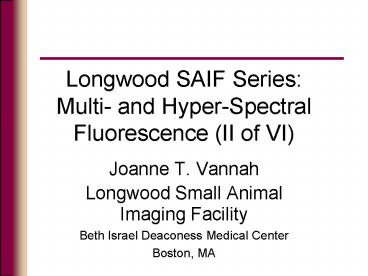Longwood SAIF Series: Multi and HyperSpectral Fluorescence II of VI - PowerPoint PPT Presentation
1 / 27
Title:
Longwood SAIF Series: Multi and HyperSpectral Fluorescence II of VI
Description:
Each tissue has distinctive transmission, absorption, and anisotropy ... s = Anisotropy (i.e. polarization) Total attenuation of light = T = S A ... – PowerPoint PPT presentation
Number of Views:27
Avg rating:3.0/5.0
Title: Longwood SAIF Series: Multi and HyperSpectral Fluorescence II of VI
1
Longwood SAIF SeriesMulti- and Hyper-Spectral
Fluorescence (II of VI)
- Joanne T. Vannah
- Longwood Small Animal Imaging Facility
- Beth Israel Deaconess Medical Center
- Boston, MA
2
Fluorescence
- The property of matter to absorb a photon at a
certain wavelength and re-emit the photon at a
lower energy state (longer wavelength) - The shift in wavelengths that occurs during the
fluorescence process (from higher to lower
energy) is known as Stokes shift
3
Three stages in fluorescence
- Excitation of molecule, fluorophore, by an
incoming photon (10-15s) - Loss of energy (10-12s)
- Emission of a longer wavelength photon and return
of molecule to ground state (10-9s)
4
Jablonski diagram
With permission from Single Molecule Optics,
MoNOS, Universiteit Leiden http//www.monos.leide
nuniv.nl/smo/index.html?basics/photophysics.htm
5
Three parameters to describe fluorescence
- Extinction coefficient
- Direct measurement of the fluorophores ability
to absorb light - High extinction coefficients increase the
probability of fluorescence emission - Quantum yield
- Ratio of photons emitted over photons absorbed
- Fluorescence lifetime
- The time during which the initial fluorescence
intensity of the fluorophore decays to 1/e of of
its initial intensity
6
Three measurements to describe optical properties
in tissues
- Each tissue has distinctive transmission,
absorption, and anisotropy - µA Absorption coefficient (cm-1)
- µs Scattering coefficient (cm-1)
- s Anisotropy (i.e. polarization)
- Total attenuation of light µ T µS µA
7
Absorption coefficient , µA
- Factors that contribute to the absorption
coefficient, µA , are listed below and are
wavelength dependent - Oxyhemoglobin
- Deoxyhemoglobin
- Lipid
- Tissue pigments
- Water (gt 1000 nm)
8
Scatter coefficient, µs
- These factors listed below contribute to scatter
and are wavelength dependent - Collagen fibrils
- Nuclei and cellular organelles
- Refractive index boundaries
9
Photobleaching
- Fluorophore has permanently lost its ability to
produce fluorescence - Occurs because of photon-induced chemical damage
- Limits to the number of excitation/emission
cycles differs depending on the fluorophore
10
Multi-spectral fluorescence
- All fluorescent materials produce a unique
spectral emission - Allows the imaging of multiple spectral bands
simultaneously - Allows the emitted fluorescence over a range of
wavelengths and records the intensity over this
range to form an emission spectrum
11
Hyper-spectral fluorescence
- Also referred to as spectral unmixing
- Allows processing of multi-spectral data to
determine pure spectra of individual components - Distinguishes between background/autofluorescence
and signal of interest - Thereby improves signal-to-background ratio
300-fold
12
CRI Maestro Multi-Spectral Fluorescence (model
500)
www.cri-inc.com
13
Hardware components
- High resolution, scientific grade CCD
- Excitation bandpass filters
- Solid-state liquid crystal tunable filter
- Longpass (emission) filters
- Light tight enclosure
- Light source Cermax 300 Watt Xenon lamp, 5600K
illumination - Wavelength range from 500-950 nm
14
Software components
- Acquire panel
- Controls needed to form new spectral images and
image cubes - Spectral processing panel
- Unmix cubes (either manually or automatically)
- Measure panel
- Find, measure, and adjust regions in images
- Display panel
- Change current display settings of images
15
Acquiring an image cube
- Exposure time and wavelength range (filters) are
selected - Light from the Xenon light source passes through
the excitation filter to the subject and
re-emitted through the emission filter, through
the liquid crystal tunable filter and longpass
emission filter - Each spectral is imaged in 3 components
- x, y, and ? where ? is the wavelength
16
Liquid crystal tunable filter
The Maestro LCTF has an OD 3 therefore a
longpass filter is used to further process ?
http//www.sprawls.org/ppmi2/
17
Longpass vs bandpass
- Because the Maestro LCTF has an OD 3, a
longpass emission filter is used - Longpass filters allows transmission of long
wavelength radiation while blocking short
wavelengths - A bandpass filter allows transmission of
frequencies within a certain range and rejects
frequencies outside that range
18
Rats labeled with fluorescent dyes
Two 300 g rats labeled with 3 fluorescent dyes
www.cri-inc.com
19
Skin (background) signal
,
www.cri-inc.com
20
Food signal
www.cri-inc.com
21
TRITC signal
www.cri.inc-com
22
Cy 3.5 Signal
www.cri-inc.com
23
FITC signal
www.cri-inc.com
24
Unmixed image of 3 dyes
- FITC, TRITC, and Cy 3.5, plus skin and food
signals
www.cri-inc.com
25
Multi- and hyper-spectral fluorescence
applications
- Tumor models
- Drug pharmacokinetics
- Angiogenesis markers
- Molecular targeting agents
- Brain slices
- Pre-histologic selection
26
Multi- and hyper-spectral fluorescence
- Pros
- Multiple, simultaneous imaging of fluorophores
and segregation into pure spectra - Highly sensitive and fast
- Cons
- Limited by time (fluorescent state is short
photobleaching) - An exogenous light source required
27
Summary
- Multi-spectral fluorescence permits the
simultaneous imaging of a range of spectra - Hyper-spectral fluorescence is the the unmixing
from multi-spectral fluorescence - Multi- and hyper-spectral fluorescence reduce
background and increase the ability to visualize
pure signals - The CRI Maestro Multi-Spectral Fluorescence
System can precisely and accurately quantify
fluorescence data































